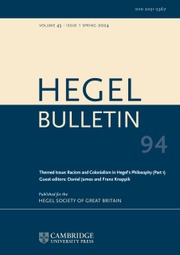No CrossRef data available.
Article contents
G. W. F. Hegel: Geometrical Studies Introduction
Published online by Cambridge University Press: 23 June 2015
Abstract
Throughout his life, Hegel showed great interest in physics and mathematics. His most sustained, surviving treatment of Euclidean geometry is his early work ‘Geometrische Studien’, which he completed while he was a private tutor [Hoffmeister] in Frankfurt, shortly before leaving for Jena to join Schelling. GS is not easy reading, but despite that, it seems to me that Hegel presents in it a remarkably erudite as well as interesting and insightful critique of geometry. He investigates some of the themes from the foundations of geometry, in particular from the first book of the Elements of Euclid. Like the mathematical philosophies of Kant and Frege, Hegel's understanding of geometry is conceptually based, but unlike them, it is also grounded in the classical Greek philosophy of mathematics, which achieved its definitive expression in Proclus's great commentary on Euclid 1. Much of this classical philosophy of geometry is forgotten nowadays, under the influence of the great modern mathematical philosophers (in particular, Cantor, Frege and Gödel). In my view, it well deserves reconsideration, especially since, as illustrated by Gödel's incompleteness theorems, modern mathematical philosophy has failed in its attempt to ground mathematics within the framework of formal systems.
Much of GS has not survived, and what remains is condensed and fragmentary. It seems that originally, Hegel covered all of the propositions of Euclid 1 rather than just the 14 propositions (1-12, 26, 29) that are covered in what remains of the original GS. I have given detailed treatment of GS together with related material in Hegel's Jena dissertation elsewhere (Paterson 2004/2005). The objective of the present paper is to introduce the translation of GS.
- Type
- Articles
- Information
- Bulletin of the Hegel Society of Great Britain , Volume 29 , Issue 1-2: number 57/58 , 2008 , pp. 118 - 131
- Copyright
- Copyright © The Hegel Society of Great Britain 2008
References
Notes
1 Abbreviations:
Dok.: Hegel, G. W. F. (1936), Dokumente zu Hegels Entwicklung. Hoffmeister, Johannes ed., Stuttgart: Frommann.Google Scholar
GS: Hegel, G.W.F (1936), ‘Geometrische Studien’, in Dok., 288–300.Google Scholar
Euclid 1: the first book of Euclid's Elements in Hea., see below.
Hea.: Euclid, (1956) The thirteen books of Euclid's Elements, Vol. 1, Heath, T. L. trans., Dover Publications: New York.Google Scholar
JL: Hegel, G. W. F (1986), The Jena System, 1804-5: Logic and Metaphysics, Burbidge, J. W. and di Giovanni, G. eds. and trans., McGill-Queen's University Press: Kingston and Montreal CrossRefGoogle Scholar. (English translation of the ‘Logik and Metaphysik’ of JS)
JS: Hegel, G.W.F (1971), Jenaer Systementwürfe II, Horstmann, R.P. and Trede, J. H. eds., Deutsche Forschungsgemeinschaft: Bonn-Bad Godesberg. (German edition)Google Scholar
Lor.: Euclid, (1781), Euklids Elemente, funf-zehn Büecher. Lorenz, J. F. tr., Halle: Oswald Seidensticker.Google Scholar
P: Proclus, (1970), Proclus: A Commentary on the first book of Euclid's Elements. Morrow, G. R. trans., Princeton University Press: Princeton, N. J.CrossRefGoogle Scholar
SL: Hegel, G.W.F. (1990), Hegel's Science of Logic. Miller, A. V. tr., Humanities Press International, Inc.:Atlantic Highlands, NJ. (English translation of WL.)Google Scholar
WL: Hegel, G.W.F. (1967), Wissenschaft der Logik, Lasson, G. ed., in two volumes, Felix Meiner: Hamburg.Google Scholar
2 The Elements was written by the Alexandrian mathematician Euclid (c. 325-265 BC). This is the most popular and influential mathematical work of all time, and its influence continues to the present day. Indeed, despite the great progress in modern mathematical philosophy, it is still the case, that, as Quine puts it, in the beginning, there was Euclidean geometry.
3 Proclus lived c. 411-485 and was, in his later years, the head of the Academy in Athens.
4 I am grateful to the referees for helpful comments. In particular, one of the referees has brought to my attention the book by Paul Zilche (1996) which is of particular relevance to Hegel's thinking about mathematics and physics in the Jena period. I am especially grateful to Professor Stephen Houlgate who subjected this translation to a painstaking and time-consuming examination; almost all of his many suggestions have been incorporated into the translation, which through them, has been greatly improved. Lastly, I am grateful to Katerina Deligiorgi for her help with getting this work into printed form.
5 I am grateful to one of the referees for pointing out that Hegel's teacher, Pfleiderer in Tübingen, adopted a German translation of the Clairaut version of Euclid, Éléments de Géométrie, in his teaching. However, following Hoffmeister, I feel that Lorenz's book is probably the more influential for Hegel since as his early Tagebuch records, he excerpted from it. For more information about Pfleiderer's work in Tübingen, the reader is referred to Paul Zilche's edition of Pfleiderer's Physics (1994).
6 For a detailed argument justifying the use of P to elucidate GS see Paterson 2004/2005.
7 For Kant (in the first chapter of the Analytic of Principles in the Kritik der reinen Vernunft) the schema of a triangle exists only in thought, and is a rule of synthesis of the imagination, in respect to pure figures in space. Again for more discussion see Paterson 2004/2005.
8 See the discussion of this in Paterson 2004/2005.
9 Of course, we are here discussing only angles in two dimensional space.
10 Hegel does say that the center is not a limit of the sphere. But (as we have seen) it is a limit of the circle? Perhaps the reason why the sphere and circle are different in this respect lies in the foundational role in geometry of the circle as the limited form of the line.
11 Cf. Hegel's discussion of the synthetic-analytic distinction in WL II, 442.; SL, 786f..
12 The postulate is stated in the translation following. Hegel briefly refers to the postulate in his treatment of geometry in WL II, 466; SL, 807-808. He says there that Euclid is correct to treat it as an axiom. For Hegel, it can only be justified by philosophy (the Concept).




